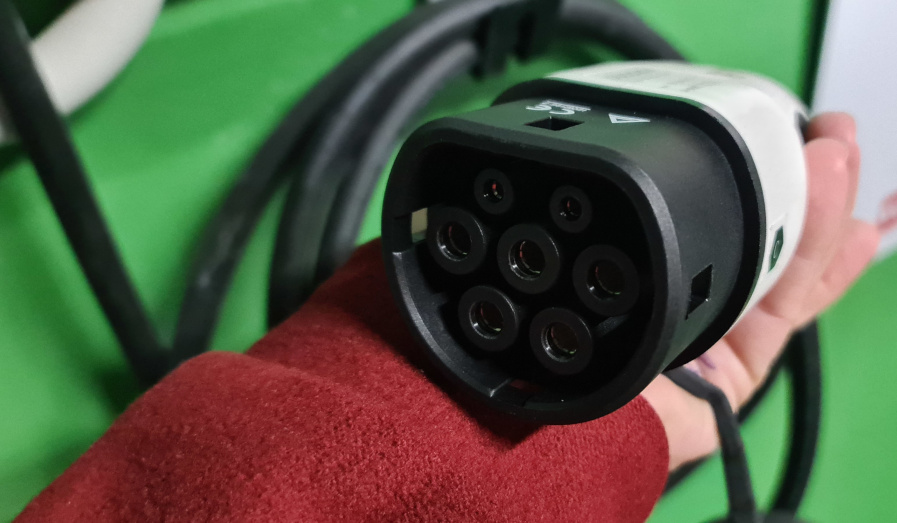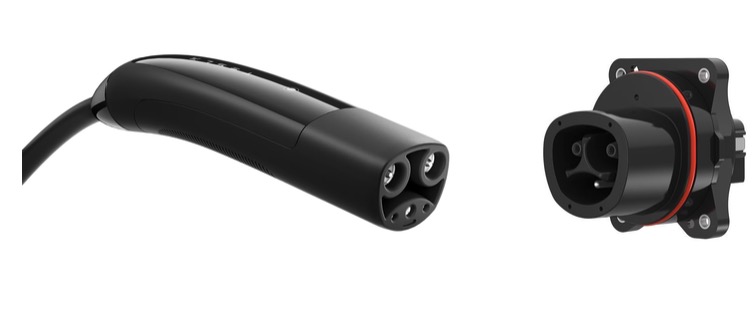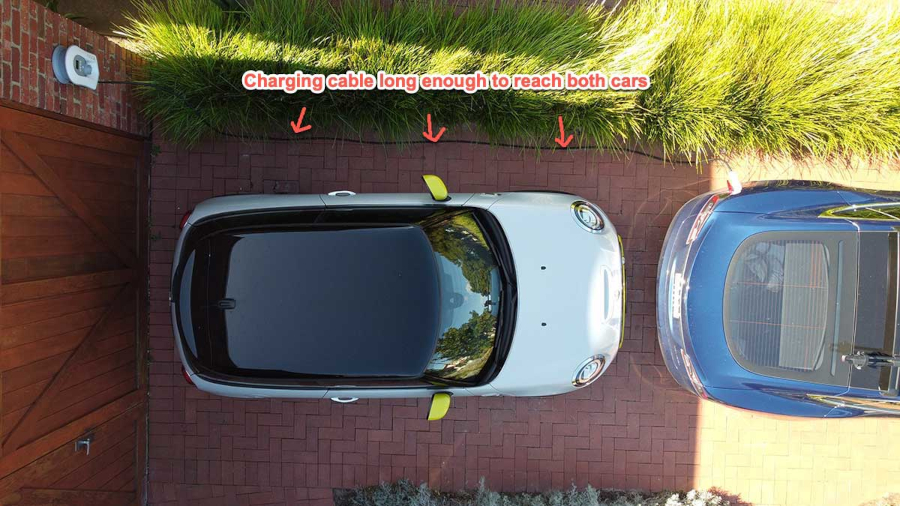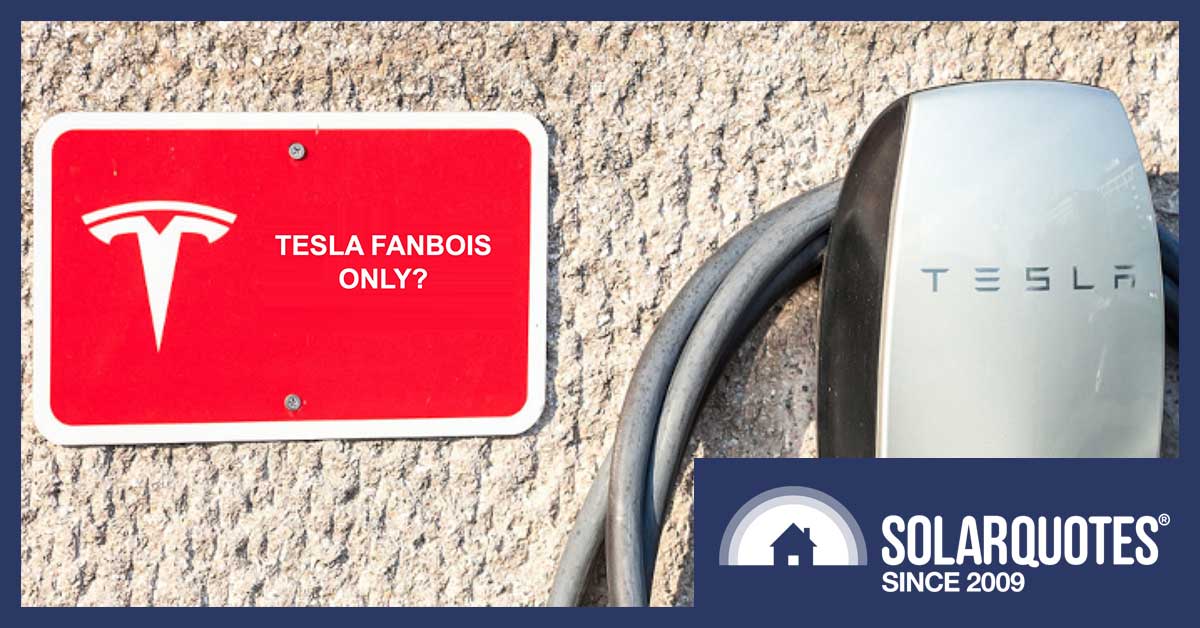As an EV enthusiast and perhaps a Tesla aficionado, you may have mulled over the question: “Is investing in a Tesla Wall Connector as my home EV charger the right move?”
If this query has been buzzing around your mind like a persistent fly at a summer barbie, you’ve come to the right place. Let’s examine the capabilities and offerings of Tesla’s latest ‘Gen 3’ Wall Connector, and see how it measures up.
First, The Basics
😮💨 You can use the Tesla Wall Connector with non-Teslas.
If you want to charge your non-Tesla EV without any smarts, the Tesla home charger is compatible with any recent EV sold in Australia.
🇦🇺 In Australia, the Tesla wall charger does not have a proprietary ‘Tesla’ plug.
Unlike the USA, almost all EVs sold in Australia, including all Teslas, have the same ‘Type 2’ socket for AC charging at home.
The Australian version of the Tesla Wall Connector has a compatible ‘Type 2’ connector plug like this:

A Type 2 connector plug.
Some Aussies assume that the Aussie version of the Tesla EV charger comes with a Tesla (NACS) style plug. It doesn’t.

The Tesla NACS plug and socket. This is the plug on a US Wall Connector, but the Aussie version comes with the larger Type 2 (& CCS2) connector. Image: Tesla
🤔 As a side-note: Last week, Ford, GM, and many charger manufacturers decided to adopt Tesla’s smaller NACS plugs in the US, hinting at the possibility of the ‘Tesla plug’ becoming the new North American standard. However, it is unlikely that NACS will become the standard in Australia due to a crucial limitation: it cannot charge vehicles with 3-Phase AC electricity. Although it does support single-phase charging up to 11 kW / 48A, which is the fastest AC rate a Tesla Model 3/Y can handle, the popularity of three-phase charging in Australia allows for charging speeds up to three times faster than the standard 32A single-phase (22kW vs 7.3kW), provided your vehicle can accommodate it. Considering this, it seems improbable that Australia would change its charging standards if it meant sacrificing the speed of three-phase charging from AC chargers.
🤷♀️ Confused by all this talk of connector types, AC/DC and EV charging in general? This video I made has everything an EV newbie needs to know in Australia:
Tesla Wall Connector Price
In the realm of EV chargers, the Tesla Gen 3 Wall Connector delivers without burning a sizeable hole in your pocket. As of 2023, it’s priced at $750 AUD. This is quite a reasonable price tag, especially when you consider the quality of the unit, Tesla’s reputation, and the generous 4-year manufacturer’s warranty. Compared to other EV chargers, its price is on par with the ‘budget’ ZJ Beny charger.
Charging Features
😭 No smart solar charging or OCPP
When it comes to smart features, the Tesla Wall Connector resembles Elon after he started courting the far-right. A confounding disappointment. The wall connector lacks a solar self-consumption function and misses out on OCPP 1.6 connectivity for third-party control and monitoring. I think these are two must-haves if you are looking for a home charger in Australia.
This scarcity of features is likely because a Tesla car is engineered to control the charging process itself. The car decides when to charge and at what rate to take power, so the charging unit on your wall doesn’t need additional functionality beyond what the car instructs.
However, this lack of ‘smartness’ is a showstopper if you want to charge a non-Tesla car with only solar power. Other brands of smart chargers can be configured for optimal charging with your solar or variable electricity tariff and will smartly charge with any brand of car plugged in. This is crucial for homes or workplaces where non-Teslas might need to charge cost-effectively.
Even the prospect of smart solar charging only for Tesla cars is not a current feature, though it is said to be in the pipeline. Exactly how the future solar charging feature works remains unclear, but it seems likely that you’ll need the full suite of Tesla products — a Tesla car, a Tesla wall connector, and a Tesla Powerwall (for its solar monitoring)— to use it once it’s available.
So, a Tesla wall charger may not be the best fit for you if you want to smart charge a non-Tesla car (or have a Tesla car but don’t have a Powerwall).
And if you want to solar charge a non-Tesla car now or in the future, you might be better off with a third-party charger that can natively solar charge, or an OCPP-compatible charger that pairs with Charge HQ.
🚗🚙🚕Three useful features for multi-EV properties
Tesla’s Wall Connector is not totally dumb – it does have three features for managing multiple cars:
- Power sharing: This uses Wi-Fi comms between multiple chargers to share the available amps, so multiple EV chargers on one supply don’t trip the main breaker when everyone charges simultaneously.
- Authorisation: The Tesla Wall Connector can be set up only to charge Teslas, authorised Teslas, or any EV, giving you flexibility and control over who can use your charger.
- Property Management (coming soon via a software update): This feature will enable the charging costs for each vehicle to be billed separately via the Tesla app. Useful for multi-vehicle households, free-loading rellies or commercial settings.
Update: A fourth feature – as pointed out by Bj in the comments – is that the Tesla Charger has a button on the plug that wirelessly opens the charging flap (or releases the plug from the socket). It’s a nice touch that you only get with Tesla chargers.
Specifications
The specs aren’t to be sneezed at; measuring 7.3 metres, Tesla offers one of the longer tethered leads, which, as I point out in my controversial ‘EV Charging Mistakes‘1, is great for reaching the charge port no matter which way you park, or even reaching a second car parked in the driveway.

It sounds basic, but the cable needs to be long enough.
The Tesla Charger provides a 32A, 7kW capacity on a single phase and, with a three-phase supply, can provide up to 22 kW, (32A per phase). But bear in mind that most EVs, including the Model 3 and Model Y can only charge at a maximum of 11 kW on three-phase due to the limit of their onboard AC-DC converters.
The 4-year warranty outlasts most competitors, and it comes with IP55 weather protection, ensuring it can withstand outdoor installations. Of course, like any electrical equipment, it’s best to shelter it where possible for added protection.
A Good Choice For Tesla-only Households. Not Great For The Rest Of Us
The Tesla Wall Connector is a strong contender if your house is all-in on Tesla products. Soon it will be able to smart solar charge, taking solar data from your Powerwall, and commanding your Tesla car to consume only solar-powered electrons.
If you only drive Teslas but don’t own a Powerwall, you can still enjoy smart solar charging with the Wall Connector if you subscribe to Charge HQ and have a compatible inverter/monitoring system – because ChargeHQ will command your car, not your Wall Connector.
Notwithstanding charging smarts, when looking at hardware, I always default back to the underlying age-old question: Is it going to be reliable? And I suspect that these would be. So I would certainly take a Tesla wall unit over a dumb, no-name charger with zero local support. But, If your household doesn’t drive Teslas, the Tesla wall charger will prevent you from smart solar charging – which means you’ll be paying more to power your electric car than you need to if you choose the Tesla Wall Connector.
Footnotes
- Only one company with BadEnergi has demanded parts be taken down ↩


 RSS - Posts
RSS - Posts



Great summary, thank you.
You may have covered this elsewhere, but what smarts does the Powerwall bring to the home charging process? You mention here Tesla vehicles have a lot of the smarts onboard, but does the Powerwall have charging smarts too?
In terms of EV charging, the Powerwall’s current sensors will be used to tell the Tesla Car how much excess solar is available, so it can throttle its charge rate to suit solar production.
It will also let the car know if a fully-backed-up house has gone off grid, so the car doesn’t drain the powerwall.
I don’t know of any other ways the Tesla cars and Powerwalls work together.
Thanks! So by extension I’m guessing that means it wouldn’t allow a Tesla EV to access the Powerwall overnight for charging, when there’s no solar production?
My Tesla car (via Delta AC Max charger) will happily drain my Powerwall overnight (to its 20% reserve). There is no option in the car to stop this.
Bizarre that they would have a system to monitor whether the homeowner is off-grid, and to monitor excess solar during the day, but not something as simple as allowing control over access to the battery overnight.
I cut my Powerwall reserve to 10% over winter, as I figured the chance of a blackout is much, much lower than the chance of me wanting additional cheap electricity for heating, every morning. Maybe that isn’t a smart option, I dunno.
The lack of smarts and OCPP in the Tesla wall charger was indeed a disappointment given how smart the rest of the car is! But, as you say, coupled with the Charge HQ app, you have a smart charger at a beer price! The 3rd party smart chargers are actually way overpriced at $2.5 to $3.5k, for basically offering smart software and doubling up on hardware already installed on most modern solar inverters.
Yes the ChargeHQ app works well with the Wall Connector but only with Tesla cars as the lack of connectivity in Tesla’s wallbox means ChargeHQ needs to control charging rate by talking directly to the Tesla car via its API. If you only need to charge Teslas it’s a great solution.
Hi Finn, just to clarify – can use the Tesla charger with ChargeHQ if you are not using a Tesla Powerwall? I am using QCell. Thanks.
Im sorry you did’nt mention a 32 amp plug on 3 phase. Why spend $500 to install 15 amp plug when when you can spend a little bit more on a 32 amp plug. Regards Hans
Apologies, the post originally said the Wall Connector could only charge at a max of 16A per phase (11 kW) on 3-phase, but that’s only with Tesla Model 3 and Model Y cars. It can handle up to 32A per phase (22 kW) if the car can handle it. So – yes – you should run cable that can handle 32A per phase.
(and I’ve corrected the post)
Great summary. However the main reason for getting the Wall connector if you have a Tesla is the button on the handle that communicates with your car.
It opens the charge port which is great but crucially it allows you to release the cable by holding the button.
The only other way to release it is to either fish out your phone or do it via the screen in the car. This minor convenience makes a warld of difference if you plug in/unplug frequently.
I don’t believe any other charger does this and is the best feature of the charger.
For sure it’s a great feature.
A really good point. I recently charged my Kona from an upgraded Charger at my local shopping centre which had refitted using the new Tesla chargers. On returning to the car I attempted to stop charging and remove the plug but couldn’t remove it. Uh Uh what to do. I hunted around but couldn’t see any means of turning off the charger. On closer inspection I noticed the small button on the hand piece. I gave it a press and bingo was able to disconnect. Bit of a trap for young players.
Hi Finn, what do you think about using the Tesla charger with a Catchpower solar relay for non-Tesla EVs? Seems cost effective at $425 for the relay.
That’s an interesting idea. I’d want to check with Tesla what they think about repeatedly killing the power to the charger though – assuming you’d use the relay to power a contactor which would kill the power when there was less than 7kW of spare solar?
That was my thought, I think the relay can be set to come on at different levels of solar export. The Zappi is a neater solution but more expensive.
I think it worth noting that the rather large price difference between something like a Zappi and the Tesla charger might take a very, very long time to recoup in savings from more effective solar harvesting. You can still crudely solar harvest using the Tesla charger by manually switching on and off and adjusting charge rates. Yes, I know not everyone wants to bother with that. A battery also makes this manual method much more effective as it provides a buffer for fluctuations in solar intensity. We have a Tesla charger and Powerwall and over the last year we only drew 2% of our power usage from the grid. This includes all charging of the EV. Another annoying thing to note with the Tesla charger is that on 3 phase you can only dial down the charging rate to 3 x 5A or 3.6kW which is often too high for effective solar harvesting on most solar systems. A one phase connection is better in that you can dial down to 1 x 5A or 1.2kW. This allows you to go up to a charge rate of 7kW (instead of 11kW for 3 phase) which is enough for the vast majority of people. We have a a 1 phase outlet in addition to our 3 phase outlet for our charger for this very reason. Still, I’m looking forward to when Tesla introduce the recently promised auto solar harvesting feature which will come as a simple OTA software update on the charger and App. When that happens the very reasonable $750 cost for the charger will become a real bargain.
With 3 phase and the chargeHQ app it can go down to ~2A, 1.4kW.
What if you have no solar and non-Tesla EV? Does the Tesla wall charger still make sense? Or better just to get ZJ Beny or cough up for a Zappi to future proof yourself in case you get solar in the future?
If you have no solar, and don’t expect to get solar in the next few years, and a non-tesla EV, then the Tesla Wall Connector is a good choice IMO. It will charge your EV just fine. Your car has likely got a timer on-board so you can configure it to only charge at off-oeak rates if you are on a time of use tariff.
Will soon have a 3 phase connection and PV system with a 10kW Fronius GEN24 Plus hybrid inverter and Fronius Smart Meter. Guess you can take control of the charging process in the same way you can control a hot water system?
(Solar Quotes: How To Use a Fronius Smart Meter To Solar Power Your Hot Water)
Assume you can also control a 3 phase load in the same way? Only difference is that you use a 3 phase contactor? (Not a sparky so not clear if it is a relay or contactor used)
Short version. Is the Wall Connector a good, controllable option in combination with Fronius Smart Meter?
I believe you would need the Energy Management Relay, a card within the inverter. I have one in my Symo, don’t know if they are there by default in all Fronius. You would only be able to turn the charger on an off, via relay connected to the Energy Management Relay and open / close the circuit the charger is on.
Not sure its worth the mucking around, but maybe with a 10kW output it is. I only have a 5kW inverter, and chose the Telsa charger for a Tesla car due to it being cheaper and not wanting to pay for technology I couldn’t utilise (OCPP). During the winter months, there isn’t enough sun on our panels, and in summer, we set the car to charge at the minimum rate, which makes the household load about 6kW when the inverter is maxed out.
The car takes about 25-30kWh every 3-4 days and trying to charge via solar wouldn’t keep up. Note we don’t have offstreet parking and can’t always guarantee to park in the street adjacent to our charger, so the 7.3m cable of the Tesla charger reaches the car via a tree which makes this charger one of the only ones suitable.
I think it’s reasonably simple to manage charging a Tesla with home assistant (if you a bit techs or have a techs friend). With Charge HQ now starting to charge for their app this is another alternative.
Yes – but only if you have a Tesla car – as the Tesla Wall Connector can’t be controlled, only the car.
Yes correct. Charging control system is in the car and available via API.
Also I believe there is a new tariff for PV/Battery owners if you’re in NSW and on Ausgrid. They are benefiting customers with better FiT who can help stabalise the grid by consuming between 08:00 and 14:00 and producing from 14:00 to 20:00 (or something like that). Better FiT after 14:00 but offset by a negative FiT before 14:00. If you have the capacity to soke up energy during the day and spit it back out again in the afternoon/evening you can make some money? Must look into this. I think you need to be with Amber Electric, maybe not? You need shiftable loads and an antimaton system to manage it though. Could be a trap is you can’t act quickly and start charging the car at home when the battery is full and the sun starts to shine (start washing the neighbours laundry?). ok for retired people who have nothing better to do than spot trade on the electricity grid.
Hi there.
Just purchased Attto 3 in Wa. Need to weigh up a Tesla wall connector or zappi.
We run 3 phase with a 5kw inverter. I intend to take advantage of the 6c per kilowatt charge by our electrical company syngery between 0900am and 300pm each day. Is it really worth it buying the expensive zappi?? I also run two pool pumps plus the myriad of appliances in the house as well. The atto 3 has a timer for charging on it as well so it could be programmed to accept energy at the appropriate times when it’s cheap. In Wa I think we can only export 7 cent a kilowatt anyway.
Tesla’s connected is 693 at jetcharge vs a zappi at approx 1600 dollars.
My math is leaning toward a Tesla changer currently……
If you are happy with:
a) the Atto’s software interface for timed charging (I ask because it’s hard to do on my Tesla and Mini – they both insist that you put a departure time in there before they’ll start charging on a timer)
b) that you won’t want to do ‘solar smart’ charging in the future
Then the Tesla Wall Connector is a wise choice.
The Zappi can be configured for off-peak charging easily without requiring any configuration of the car.
Great site Finn, I read and enjoy a lot of your articles. Unlike yourself however, I find Elons latest actions hugely encouraging and positive 🙂
Awesome site and very informative article, really helpful being local in SA, I am waiting on my Tesla Model 3 delivery, sometime in next couple weeks 🙂 and am trying to decide on charger, I just ordered the Tesla mobile charger, so I have a bit of time to decide on a quicker home charger. I have 11Kw solar and have had a Powerwall for 2+ years and since getting Powerwall, I haven’t had to pay for electricity, current bill is -$300
I am leaning towards the Tesla charger mainly for the button to open the charge port and so everything is Tesla, has anyone had any experience with the Drive on sunshine update and how that is going? or any advice on other options and what else I might need?
Also do I need to buy a seperate type 2 cable to carry around to charge at non supercharger sites?
Hi Finn, there is one question I just cannot find an answer for and which will determine whether I will buy a Tesla Wall Connector for my Mazda CX60 PHEV or look for a more expensive option. The question is related to the Tesla APP and all the associated “smart controls” – my understanding is that the APP wIll will only work if you own a Tesla.
I know that the Wall Connector is compatible with all EV’s in Australia, however what I don’t know is whether the TWC will recognise my car’s charging schedule, i.e. if I set a schedule with the in-car option (via Mazda’s Infotainment system) and plug in the TWC cable, will it go in standby mode (solid blue light) awaiting my Mazda’s charging schedule, or can I only charge “live” if not a Tesla? I want the ability to use cheaper overnight rates (starting 11pm in WA) even if I go to bed much earlier.
I have a Tesla powerwall and a non-Tesla EV, what’s the best EV charger to have so I only charge the EV with my excess solar?
Hi Shane,
I’ve heard nothing but good reports about using ChargeHQ to coordinate smart charging, however there’s a subscription involved.
If you’re more inclined to do some technical work yourself using APIs then I understand Home Assistant is a really good platform for automating anything that has open communication protocols and it doesn’t require an internet connection.
I’ve added EMHASS to my home assistant system to calculate best time to charge and dischage the house battery and when to charge the car and when to run the pool pump etc.
I have Amber Electric as my supplier, and they provide a variable supply and feed-in tariff similar to the wholesale market so I can arbitrage the energy flow.
Haven’t had an electricity bill since setting it up and so far I’ve made enough out of arbitrage to charge the EV for free. My electricity bill is well in credit at the moment after two months of operation.
That’s with a battery that is limited to 3.3kW in and out and 5kWp PV so you can do a lot better with more powerful batteries like Tesla PW.
Hi Shane,
MyEnergi and Evnex chargers that will do this and are about the same price. I like the look of the Evnex, but haven’t owned one. Personally, I’m not a fan of MyEnergi having owned one.
Finn